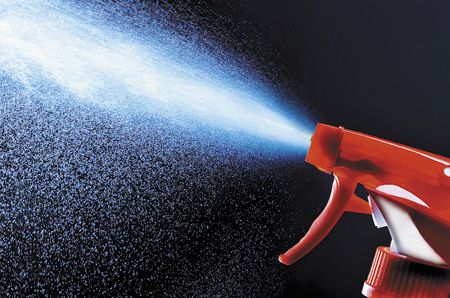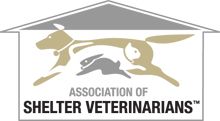Shelter Snapshot: What to put in that spray bottle
Tips for your practice from an animal shelter on which disinfectants to turn to and why it matters.

(shutterstock.com)Parvo lurking in the corner of a cage. Calcivirus on the countertop. While it's tempting to just use whatever your practice or shelter has always put in the spray bottle or foamer, veterinarians can and should play an active role in choosing disinfectants.
What are my disinfectant choices?
Disinfectant choices run the gamut from big guns that will kill most common companion animal pathogens to products with more modest disinfectant abilities. The more comprehensive disinfectants can carry some downsides, such as cost and lack of user-friendliness for staff, including strong disinfectant odors or residues left on surfaces. It's important to assess your need based on what infectious diseases you are likely to encounter in your practice or shelter. Consider your resources when choosing a disinfectant, including your budget, team time, and team training and expertise.
So let's look at what scenario you're facing right now.
Scenario 1: I definitely have a risk of encountering calicivirus, panleukopenia, parvovirus or ringworm.
Most shelters need to consider a daily disinfectant that protects against common pathogens such as parvovirus, feline calicivirus or feline panleukopenia. At minimum, it's important for a shelter or veterinary practice to have disinfectants on hand to use in cases of diagnosed or suspected diseases.
One of the most common heavy-hitting disinfectants is sodium hypochlorite, or bleach. It's usually used at a 1:32 dilution that kills most commonly encountered pathogens, including parvovirus and panleukopenia. When the concentration is increased to 1:10, it will even kill ringworm spores. However, bleach won't work if any organic debris is present and, even at its routine concentration, it can be corrosive to metal and noxious both for team members and animals. Just ask shelter employees to show you what bleach does to their rubber boots!
Newer chlorine-based disinfectant compounds have similar efficacy to bleach but are less corrosive. These include Wysiwash (calcium hypochlorite) and Bru-Clean (sodium dichloroisocyanurate). However, these disinfectants still don't work well if organic debris is present, so a thorough cleaning is necessary before disinfecting.
Rescue (accelerated hydrogen peroxide), formerly known as Accel, has a broad range of coverage, including efficacy against feline calicivirus, parvovirus, panleukopenia and possibly dermatophytes. Accelerated hydrogen peroxide is user-friendly for staff, is safe for animals and has some efficacy even if organic debris is present due to its detergent properties. It's more expensive than the chlorine-based disinfectants, but that cost is at least in part outweighed by a shorter contact time. Accelerated hydrogen peroxide can also be used to disinfect such items as endotracheal (ET) tubes or the pulse oximeter probe at a lower dilution, though it can degrade plastic (particularly delicate ET tube cuffs) when left on too long.
Trifectant (potassium peroxymonosulfate) is another disinfectant with broad-spectrum coverage against calicivirus, parvovirus and panleukopenia. It has traditionally been considered ineffective against dermatophytes, but recent studies indicate some efficacy.1 Similar to accelerated hydrogen peroxide, this disinfectant has detergent properties and still works even if some organic debris is present; it has fewer noxious side effects than bleach. While also more expensive than the chlorine disinfectants, Trifectant typically costs slightly less than accelerated hydrogen peroxide. It can be purchased in powder or tablet form that is reconstituted and lasts for seven days.
Scenario 2: The infectious disease risk for my facility is pretty low.
Not every facility needs to use a broad-spectrum disinfectant regularly. Less comprehensive disinfectants may be the right choice for a small limited-admission shelter with a relatively low-risk population or for daily use in a veterinary clinic if serious infectious diseases such as parvovirus or panleukopenia are uncommon.
Another common class of veterinary disinfectants are the quaternary ammonium compounds, or “quats,” such as Roccal-D Plus or KennelSol. Products in this category vary in cost, efficacy, and detergent and degreasing abilities. When choosing a disinfectant, read the specifics of that particular product. But keep in mind that as a group they're not reliably effective against nonenveloped viruses, such as canine adenovirus, parvovirus, panleukopenia or feline calicivirus. Because cats can develop ulcers if their oral mucosa comes in contact with quats, make sure the surface is rinsed and dried thoroughly after application.Though it's important to know their limitations and side effects, these disinfectants can still be practical and cost-effective in the right setting.
The phenolic compounds are another common disinfectant option, but don't use these in an animal shelter or a veterinary practice because they could be toxic to cats.
Scenario 3: I'm worried about a specific disease. What should I use?
Below is a list of common companion animal pathogens and the disinfectants effective against them. These disinfectants are effective only if used according to the manufacturers' recommendations for dilution and contact time. Also remember that infection control is about more than just disinfecting. Your infectious disease protocol should include details about the entire sanitation and disease control processes.
Table 1: Disinfectant options for veterinary practice
Pathogen
Disinfectants that can be used
Bordetella bronchiseptica
(kennel cough) Bleach and other chlorine-based disinfectants, Rescue, Trifectant, quats (The exception is canine adenovirus, which is not always destroyed by quats.) Canine parvovirus Rescue, Trifectant, bleach and other chlorine-based disinfectants
Giardia
species (trophozoite stage) Bleach and other chlorine-based disinfectants, Rescue, Trifectant, quats Feline herpesvirus Bleach and other chlorine-based disinfectants, Rescue, Trifectant, quats Feline calicivirus Rescue, Trifectant, bleach and other chlorine-based disinfectants Feline panleukopenia virus Rescue, Trifectant, bleach and other chlorine-based disinfectants Dermatophytes (ringworm) 1:10 dilution bleach*
*Only 1:10 dilution bleach reliably kills dermatophyte spores, though recent research suggests that other disinfectants, including accelerated hydrogen peroxide and quats, may be more effective than previously thought.1
Disinfectant choice is vital to sanitation protocols both in shelters and veterinary practices. Know what you're using, even if you already have protocols in place.
Reference
1. Moriello KA, Kunder D, Hondzo H. Efficacy of eight commercial disinfectants against Microsporum canis and Trichophyton spp. infective spores on an experimentally contaminated textile surface. Vet Dermatol 2013;24(6):621-623, e151-e152.
Suggested reading
• Rutala WA, Weber DJ, Healthcare Infection Control Practices Advisory Committee. Centers for Disease Control and Prevention. Guidelines for disinfection and sterilization in healthcare facilities, 2008. Available at: www.cdc.gov/hai/pdfs/disinfection_nov_2008.pdf. Accessed March 14, 2017.
• Addie DD, Boucraut-Baralon C, Egberink H, et al. Disinfectant choices in veterinary practices, shelters and households: ABCD guidelines on safe and effective disinfection for feline environments. J Feline Med Surg 2015;17:594-605.
• Steneroden K. Sanitation. In: Miller L, Zawistowski S, eds. Shelter medicine for veterinarians and staff. 2nd ed. Ames, Iowa: John Wiley & Sons, 2013;37-48.

"Shelter Snapshot" is a collaborative column between the Association of Shelter Veterinarians (ASV) and dvm360.com to help inform veterinarians and team members involved in veterinary shelter medicine and in related aspects of veterinary general practice. To learn more about the ASV and to find the “Guidelines for Standards of Care in Animal Shelters,” Position Statements on a variety of topics, and other resources, visit sheltervet.org.
Erin Doyle, DVM, is the vice president of the Associate of Shelter Veterinarians and the lead veterinarian of Shelter Veterinary Services at the Animal Rescue League of Boston.











